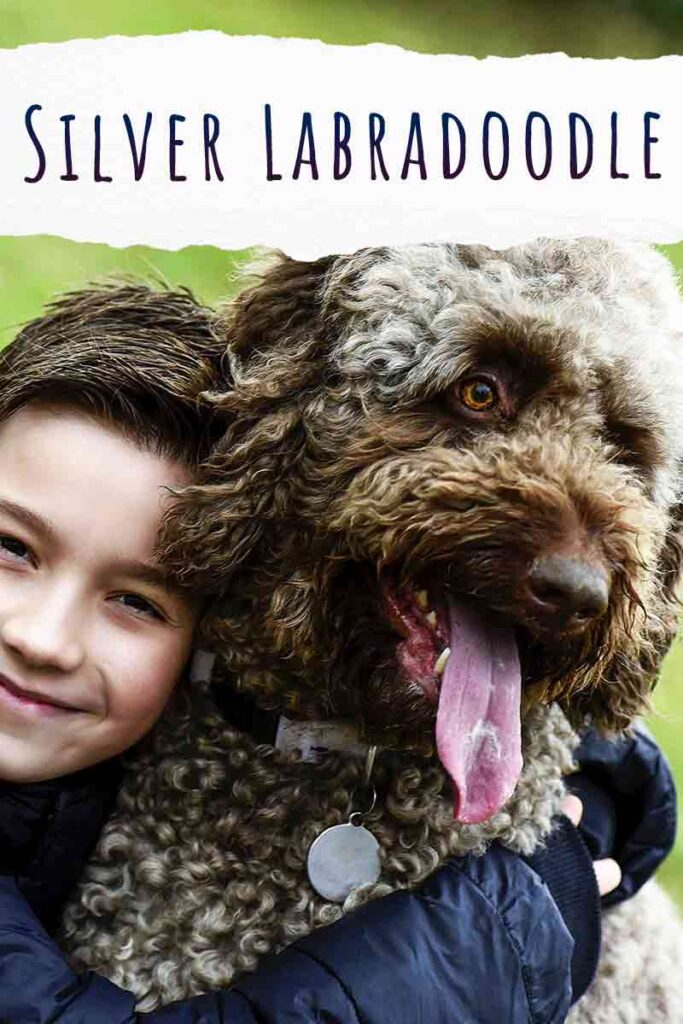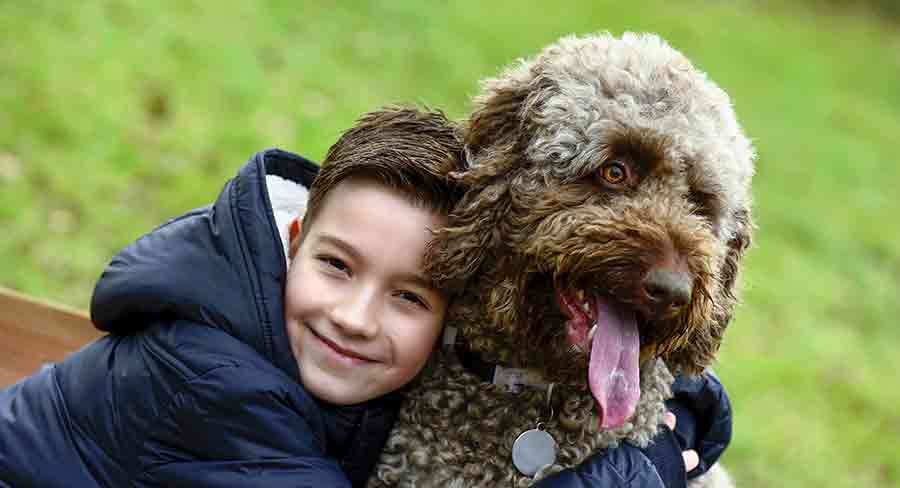A silver Labradoodle has a unique and unusual combination of genes that determine their coat color. They are friendly, loving and loyal dogs, with a high activity level and full of fun.
They’re beautiful to look at, and yet they have a surprising scandal in their family tree. People considering adopting a silver Labradoodle puppy also need to be aware of how their heritage influences their temperament, and their health.
What Is A Silver Labradoodle?
Labradoodles are a cross between Labrador Retrievers and Poodles. They inherit characteristics from both parent breeds, including coat color. Silver Labradoodles actually have a very pale brown coat. Because there’s only a small amount of pigment in it, it appears to shimmer like silver.
Silver coat color is common in all three types of Poodle: Standard, Miniature, and Toy. Some Labradors are silver too, but they are much less common than silver Poodles.
In fact, neither parent of a litter needs to have a silver coat to produce silver Labradoodle puppies. And that’s all because of the magic of genetics.

Silver Labradoodle Genetics
The coat color in silver labs and labradoodles is caused by color dilution genes in a dog’s DNA. Color dilution genes inhibit the amount of pigment produced in fur, so that it looks pale and ethereal.
Dilution genes are recessive, which means that when a dog only has one copy, it isn’t expressed. In other words they are a carrier for color dilution, but they don’t have a dilute-colored coat.
For a Labradoodle to have a silver coat, they need to inherit color dilution genes from both parents. They also need to inherit the genetic recipe for a brown coat (compared to, say, a black or red coat). Which brings us back to why silver Labradoodles are unusual…
Silver Poodles
This curly canine can have many different coat colors. These include brown, and several dilute colors including silver (which is diluted brown), gray (which is diluted black) and apricot (which is diluted red).
Poodles with brown and/or dilute coat colors will always pass on the genes for brown and/or color dilution to their puppies. But Poodles in other colors like black might also carry these genes silently, and pass them on to their offspring.
Silver Labrador Retrievers
As we’ve already said though, it’s not enough for a silver Labradoodle to inherit color dilution from their Poodle parent alone. They need the same genes from their Labrador parent too, and this is where it gets controversial.
The traditional coat colors of the Labrador Retriever are black, yellow, and chocolate. Only around 1% of Labs carry the color dilution gene, and even fewer have two copies. A lot of Labrador fans believe the presence of color dilution genes means that a Lab comes from breeding lines that have been mixed with Weimaraners in the past. In other words, they’re not purebred Labradors at all.
Since this has never been genetically proven, the American Kennel Club (AKC) accepts Labs with dilute coat colors on their register. But their existence remains divisive, and that’s why finding a Lab who has a dilute coat or carries the dilution gene can be an obstacle to producing silver Labradoodle puppies.
Silver Labradoodle breeding
There are a couple of ways Labradoodle breeders can get around this obstacle if they particularly wish to produce silver Labradoodle puppies. One is to breed F2 Labradoodles.
F2 Labradoodles are the result of breeding two first generation Labradoodles. In other words, their parents were Labradoodles, but their grandparents were Poodles and Labradors. If both of the Poodle grandparents had dilute coat colors, then statistically one quarter of their grandpuppies will do too.
Another way to increase the odds of silver Labradoodles without using a silver Lab is to mate a Labradoodle from a dilute colored Poodle parent to another dilute Poodle. Their puppies will be 75% Poodle and 25% Lab, and about half of them will have dilute coats.
As beautiful as silver Labradoodles are though, the true hallmark of a good breeder is one who prioritizes the health and temperament of their puppies over their color. So let’s see what you should expect from those next.
Silver Labradoodle Temperament
Labradoodles of all colors can take very much after one of their parents, or inherit a mix of characteristics from both. Labs and Poodles are both clever and energetic. They love working closely alongside people, which makes them highly responsive to training.
They both share an affinity for water, and a fondness for retrieving games. However, the Poodle can sometimes be more wary of unfamiliar people than Labradors.
There’s no known direct connection between silver coat color, and any changes in temperament. However, brown Labradors have a reputation for being more excitable and less successful at elite level field training than black and yellow Labs (remember that silver is dilute brown – silver Labradoodles usually comes from chocolate Labrador lines).
The most reliable way to predict what kind of personality a silver Labradoodle puppy will have when they grow up is to meet both of their parents, and decide if you get on with them. A good Labradoodle breeder will be happy to help arrange this.
Silver Labradoodle Health
Reputable Labradoodle breeders also produce healthy puppies by only using breeding dogs which have been screened for known hereditary conditions. For Labradors that means:
- hip dysplasia
- elbow dysplasia
- eye disease
- heart disease
- centronuclear myopathy
- and exercise induced collapse.
For Poodles it means:
- hip dysplasia
- and eye disease.
Furthermore, the silver coat color is associated with a condition known as color dilution alopecia (CDA). CDA causes hair thinning and loss, as well as patches of itchy, flaky skin.
Why does this happen?
Experts think color dilute dogs have abnormal hair follicles. Symptoms of CDA show up in dogs 6 months of age or older.
Some silver dogs are more prone to CDA than others. Standard Poodles are on the list of breeds that can experience CDA. Canine health experts say that dogs with CDA should not be used in breeding programs.
Silver Labradoodle Puppies
If you want a classic silver Labradoodle, be sure to work with a reputable and experienced breeder who will share your puppy’s full ancestry and their parents’ health certificates with you. Good breeders usually have waiting lists for their puppies!
When you meet a silver Labradoodle puppy for the first time, it is likely that they will be dark, not silver, in color. Their coat color lightens as they mature. It takes time for a silver Doodle to reach its adult color – sometimes as long as 3 years.
It also can be hard to predict exactly how a dog’s coat will fade – the final tone can range from light to dark, and be even or mottled.
Silver Beige Labradoodles
A puppy with a brown coat can also fade to other colors that are somewhat like silver, such as lavender or silver beige. The silver beige Labradoodle is still silver genetically, but might have a little different coat color to their truly silver sisters.
These puppies have brownish noses while true silver puppies have black noses.
Is A Silver Labradoodle Right For Me?
Your decision to get a silver Labradoodle (or any dog) should be based on careful consideration and research. If the silver color and pure Labrador and Poodle ancestry are important to you, be sure to talk to several reputable breeders about how they breed for the silver color.
It’s also important to remember that there are no guarantees about exactly what shade of silver your Labradoodle will be. Ultimately, the Labradoodle’s affectionate, happy, and social nature is what makes this mixed breed dog such a popular choice, especially for families with young children. While appearance is a factor in many people’s choices, good temperament and good health are more important in silver Labradoodles…or any dog!
Do you already have a silver Labradoodle?
We’d love to hear more about them in the comments box down below!
References and Further Reading
- “AKC-LRC Joint Statement on Alleged Silver Labradors.” American Kennel Club and The Labrador Retriever Club, Inc., 2017.
- Downing, R. “Color Dilution Alopecia in Dogs.” VCA Hospitals.
- Schmutz, S.M., Berryere, T.G. “Genes Affecting Coat Colour and Pattern in Domestic Dogs: A Review.” Animal Genetics, 2007.


I thought the silver labradoodle was a great unique color. Seems he may be a bit of a misfit.
Either way, he is the love of my life.
Our silver lab or doodle is wonderful pit. She does have a one owner disposition but she is very loving and affectionate. Her temperament is as good as I have ever seen our grandbabies or around them quite often and again they are very loving. Definitely need lots of room for play as they are very active love water chasing things etc. etc.